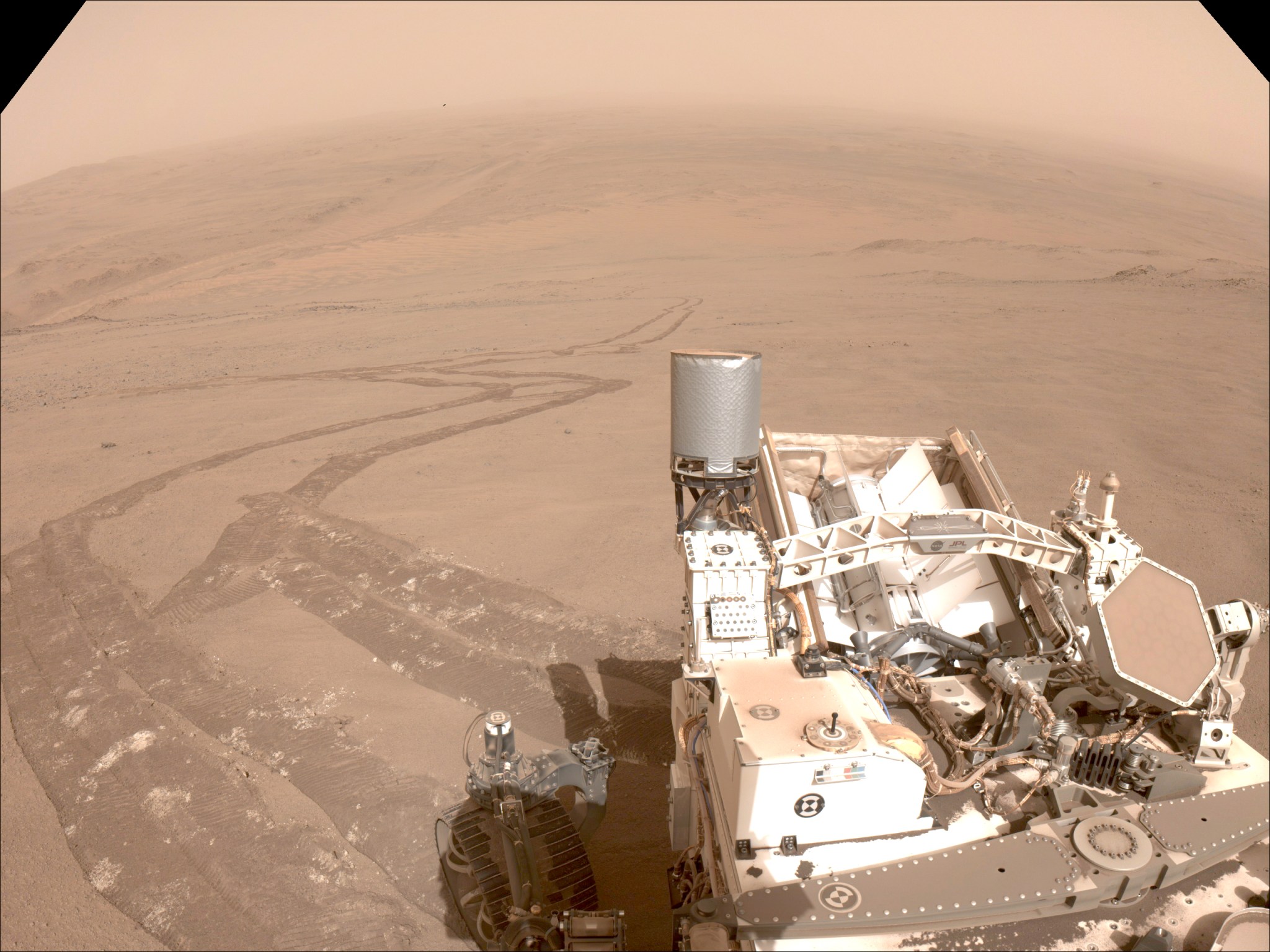6 min read
Preparations for Next Moonwalk Simulations Underway (and Underwater)  This enhanced-color mosaic was taken on Sept. 27 by the Perseverance rover while climbing the western wall of Jezero Crater. Many of the landmarks visited by the rover during its 3½-year exploration of Mars can be seen.NASA/JPL-Caltech/ASU/MSSS On its way up the side of Jezero Crater, the agency’s latest Red Planet off-roader peers all the way back to its landing site and scopes the path ahead.
This enhanced-color mosaic was taken on Sept. 27 by the Perseverance rover while climbing the western wall of Jezero Crater. Many of the landmarks visited by the rover during its 3½-year exploration of Mars can be seen.NASA/JPL-Caltech/ASU/MSSS On its way up the side of Jezero Crater, the agency’s latest Red Planet off-roader peers all the way back to its landing site and scopes the path ahead.
NASA’s Perseverance Mars rover is negotiating a steeply sloping route up Jezero Crater’s western wall with the aim of cresting the rim in early December. During the climb, the rover snapped not only a sweeping view of Jezero Crater’s interior, but also imagery of the tracks it left after some wheel slippage along the way.
 An annotated version of the mosaic captured by Perseverance highlights nearly 50 labeled points of interest across Jezero Crater, including the rover’s landing site. The 44 images that make up the mosaic were taken Sept. 27.NASA/JPL-Caltech/ASU/MSSS Stitched together from 44 frames acquired on Sept. 27, the 1,282nd Martian day of Perseverance’s mission, the image mosaic features many landmarks and Martian firsts that have made the rover’s 3½-year exploration of Jezero so memorable, including the rover’s landing site, the spot where it first found sedimentary rocks, the location of the first sample depot on another planet, and the final airfield for NASA’s Ingenuity Mars Helicopter. The rover captured the view near a location the team calls “Faraway Rock,” at about the halfway point in its climb up the crater wall.
An annotated version of the mosaic captured by Perseverance highlights nearly 50 labeled points of interest across Jezero Crater, including the rover’s landing site. The 44 images that make up the mosaic were taken Sept. 27.NASA/JPL-Caltech/ASU/MSSS Stitched together from 44 frames acquired on Sept. 27, the 1,282nd Martian day of Perseverance’s mission, the image mosaic features many landmarks and Martian firsts that have made the rover’s 3½-year exploration of Jezero so memorable, including the rover’s landing site, the spot where it first found sedimentary rocks, the location of the first sample depot on another planet, and the final airfield for NASA’s Ingenuity Mars Helicopter. The rover captured the view near a location the team calls “Faraway Rock,” at about the halfway point in its climb up the crater wall.
“The image not only shows our past and present, but also shows the biggest challenge to getting where we want to be in the future,” said Perseverance’s deputy project manager, Rick Welch of NASA’s Jet Propulsion Laboratory in Southern California. “If you look at the right side of the mosaic, you begin to get an idea what we’re dealing with. Mars didn’t want to make it easy for anyone to get to the top of this ridge.”
Visible on the right side of the mosaic is a slope of about 20 degrees. While Perseverance has climbed 20-degree inclines before (both NASA’s Curiosity and Opportunity rovers had crested hills at least 10 degrees steeper), this is the first time it’s traveled that steep a grade on such a slippery surface.
This animated orbital-map view shows the route NASA’s Perseverance Mars rover has taken since its February 2021 landing at Jezero Crater to July 2024, when it took its “Cheyava Falls” sample. As of October 2024, the rover has driven over 30 kilometers (18.65 miles), and has collected 24 samples of rock and regolith as well as one air sample. NASA/JPL-Caltech Soft, Fluffy During much of the climb, the rover has been driving over loosely packed dust and sand with a thin, brittle crust. On several days, Perseverance covered only about 50% of the distance it would have on a less slippery surface, and on one occasion, it covered just 20% of the planned route.
“Mars rovers have driven over steeper terrain, and they’ve driven over more slippery terrain, but this is the first time one had to handle both — and on this scale,” said JPL’s Camden Miller, who was a rover planner, or “driver,” for Curiosity and now serves the same role on the Perseverance mission. “For every two steps forward Perseverance takes, we were taking at least one step back. The rover planners saw this was trending toward a long, hard slog, so we got together to think up some options.”
On Oct. 3, they sent commands for Perseverance to test strategies to reduce slippage. First, they had it drive backward up the slope (testing on Earth has shown that under certain conditions the rover’s “rocker-bogie” suspension system maintains better traction during backward driving). Then they tried cross-slope driving (switchbacking) and driving closer to the northern edge of “Summerland Trail,” the name the mission has given to the rover’s route up the crater rim.
To view this video please enable JavaScript, and consider upgrading to a web browser that supports HTML5 video
NASA’s Perseverance drives first backward then forward as it negotiates some slippery terrain found along a route up to the rim of Jezero Crater on Oct. 15. The Mars rover used one of its navigation cameras to capture the 31 images that make up this short video.NASA/JPL-Caltech Data from those efforts showed that while all three approaches enhanced traction, sticking close to the slope’s northern edge proved the most beneficial. The rover planners believe the presence of larger rocks closer to the surface made the difference.
“That’s the plan right now, but we may have to change things up the road,” said Miller. “No Mars rover mission has tried to climb up a mountain this big this fast. The science team wants to get to the top of the crater rim as soon as possible because of the scientific opportunities up there. It’s up to us rover planners to figure out a way to get them there.”
Tube Status In a few weeks, Perseverance is expected to crest the crater rim at a location the science team calls “Lookout Hill.” From there, it will drive about another quarter-mile (450 meters) to “Witch Hazel Hill.” Orbital data shows that Witch Hazel Hill contains light-toned, layered bedrock. The team is looking forward to comparing this new site to “Bright Angel,” the area where Perseverance recently discovered and sampled the “Cheyava Falls” rock.
 Tracks shown in this image indicate the slipperiness of the terrain Perseverance has encountered during its climb up the rim of Jezero Crater. The image was taken by one of rover’s navigation cameras on Oct. 11. NASA/JPL-Caltech The rover landed on Mars carrying 43 tubes for collecting samples from the Martian surface. So far, Perseverance has sealed and cached 24 samples of rock and regolith (broken rock and dust), plus one atmospheric sample and three witness tubes. Early in the mission’s development, NASA set the requirement for the rover to be capable of caching at least 31 samples of rock, regolith, and witness tubes over the course of Perseverance’s mission at Jezero. The project added 12 tubes, bringing the total to 43. The extras were included in anticipation of the challenging conditions found at Mars that could result in some tubes not functioning as designed.
Tracks shown in this image indicate the slipperiness of the terrain Perseverance has encountered during its climb up the rim of Jezero Crater. The image was taken by one of rover’s navigation cameras on Oct. 11. NASA/JPL-Caltech The rover landed on Mars carrying 43 tubes for collecting samples from the Martian surface. So far, Perseverance has sealed and cached 24 samples of rock and regolith (broken rock and dust), plus one atmospheric sample and three witness tubes. Early in the mission’s development, NASA set the requirement for the rover to be capable of caching at least 31 samples of rock, regolith, and witness tubes over the course of Perseverance’s mission at Jezero. The project added 12 tubes, bringing the total to 43. The extras were included in anticipation of the challenging conditions found at Mars that could result in some tubes not functioning as designed.
NASA decidedto retire two of the spare empty tubes because accessing them would pose a risk to the rover’s small internal robotic sample-handling arm needed for the task: A wire harness connected to the arm could catch on a fastener on the rover’s frame when reaching for the two empty sample tubes.
With those spares now retired, Perseverance currently has 11 empty tubes for sampling rock and two empty witness tubes.
More About Perseverance A key objective of Perseverance’s mission on Mars is astrobiology, including caching samples that may contain signs of ancient microbial life. The rover will characterize the planet’s geology and past climate, to help pave the way for human exploration of the Red Planet and as the first mission to collect and cache Martian rock and regolith.
NASA’s Mars Sample Return Program, in cooperation with ESA (European Space Agency), is designed to send spacecraft to Mars to collect these sealed samples from the surface and return them to Earth for in-depth analysis.
The Mars 2020 Perseverance mission is part of NASA’s Moon to Mars exploration approach, which includes Artemis missions to the Moon that will help prepare for human exploration of the Red Planet.
NASA’s Jet Propulsion Laboratory, which is managed for the agency by Caltech, built and manages operations of the Perseverance rover.
For more about Perseverance:
https://science.nasa.gov/mission/mars-2020-perseverance
News Media Contacts Karen Fox / Molly Wasser
NASA Headquarters, Washington
202-358-1600
karen.c.fox@nasa.gov / molly.l.wasser@nasa.gov
DC Agle
Jet Propulsion Laboratory, Pasadena, Calif.
818-393-9011
agle@jpl.nasa.gov
2024-146
Keep Exploring Discover Related Topics Missions



 6 min read NASA Successfully Integrates Coronagraph for Roman Space Telescope Article 8 hours ago
6 min read NASA Successfully Integrates Coronagraph for Roman Space Telescope Article 8 hours ago  4 min read Could Life Exist Below Mars Ice? NASA Study Proposes Possibilities Article 2 weeks ago
4 min read Could Life Exist Below Mars Ice? NASA Study Proposes Possibilities Article 2 weeks ago  4 min read New Team to Assess NASA’s Mars Sample Return Architecture Proposals NASA announced Wednesday a new strategy review team will assess potential architecture adjustments for the…
4 min read New Team to Assess NASA’s Mars Sample Return Architecture Proposals NASA announced Wednesday a new strategy review team will assess potential architecture adjustments for the…



